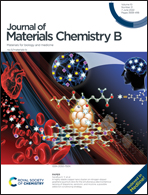Bio-fabricated nanocomposite hydrogel with ROS scavenging and local oxygenation accelerates diabetic wound healing†
Abstract
Chronic wounds, especially diabetic wounds, involve abnormally long inflammatory periods due to their pathological microenvironment of high reactive oxygen species (ROS) levels and lack of blood vessels. Here, via a mild, simple and feasible fabrication approach, a sustained oxygenation system is proposed, consisting of MnO2 nanosheets and a dual-network hydrogel fabricated from natural biomaterials including silk fibroin (SF) and carboxymethyl cellulose (CMC). Compared with the initial value (61.09 kPa), the compression modulus of the dual-network hydrogel increased by 116.2% through the coordination of strong covalent bonds and sacrificial coordination bonds constructed by enzymatic crosslinking and UV-irradiation crosslinking; the intrinsic shear-thinning effect endows the dual-network hydrogel with satisfactory injectable properties to be customized as a predetermined shape to accommodate the irregular wounds of diabetes. The encapsulated MnO2 nanosheets can catalyze the excessive ROS into necessary O2in situ and, after co-incubating with the SF/CMC@MnO2 hydrogels, cells in oxidative stress show significantly lower ROS (3 times) and higher O2 (17 times) levels that are conductive to relieving oxidative stress, promoting angiogenesis and reducing inflammation in vivo. Meanwhile, these SF-based hydrogels can offset the overexpression of matrix metalloproteinases (MMPs) in diabetic wounds (more than 80%) and promote remodeling of the extracellular matrix. Eventually, wound healing rates >76% in 7 days and 100% in 14 days were achieved by the bio-fabricated nanocomposite hydrogel and are remarkably faster than the commercial dressing healing rates (<30% in 7 days and <80% in 14 days). These results indicate that this bio-fabricated hydrogel system with multiple and customizable functions has great promise in the personalized clinical care of chronic wounds.



 Please wait while we load your content...
Please wait while we load your content...